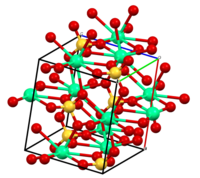
Photo from wikipedia
Abstract The present article illustrates the acid and sulfate resistance performance of control (CM) and the hydrogen-rich water-based mortar (HM) samples. The 28 days cured CM and HM samples were exposed… Click to show full abstract
Abstract The present article illustrates the acid and sulfate resistance performance of control (CM) and the hydrogen-rich water-based mortar (HM) samples. The 28 days cured CM and HM samples were exposed to 5% HCl, 5% HNO3, and 5% sodium sulfate solutions for 30, 60, 90, 120, 150, and 180 days to evaluate their acid and sulfate resistance performances. The impact of acid and sulfate attack was evaluated measuring the weight and compressive strength loss of mortar samples in the different exposure regimes. Additionally, water absorption, porosity, and sorptivity tests were performed to evaluate the transport properties of the mortars. Analyzing the result, a lesser extent of compressive strength loss (47.63% in HCl, 39.47% in HNO3, and 3% in Na2SO4) was observed for the hydrogen-rich water-based mortar as compared to that of the control mortar (57.33% in HCl, 55.4% in HNO3, and 14% in Na2SO4) after 180 days exposure. Based on the X-ray diffraction, Fourier transform infrared spectroscopy, and scanning electron microscopy analysis, a plausible mechanism has been proposed to explain the beneficial effect of the hydrogen-rich water-based mortars against acid and sulfate attacks.
Journal Title: Construction and Building Materials
Year Published: 2017
Link to full text (if available)
Share on Social Media: Sign Up to like & get
recommendations!